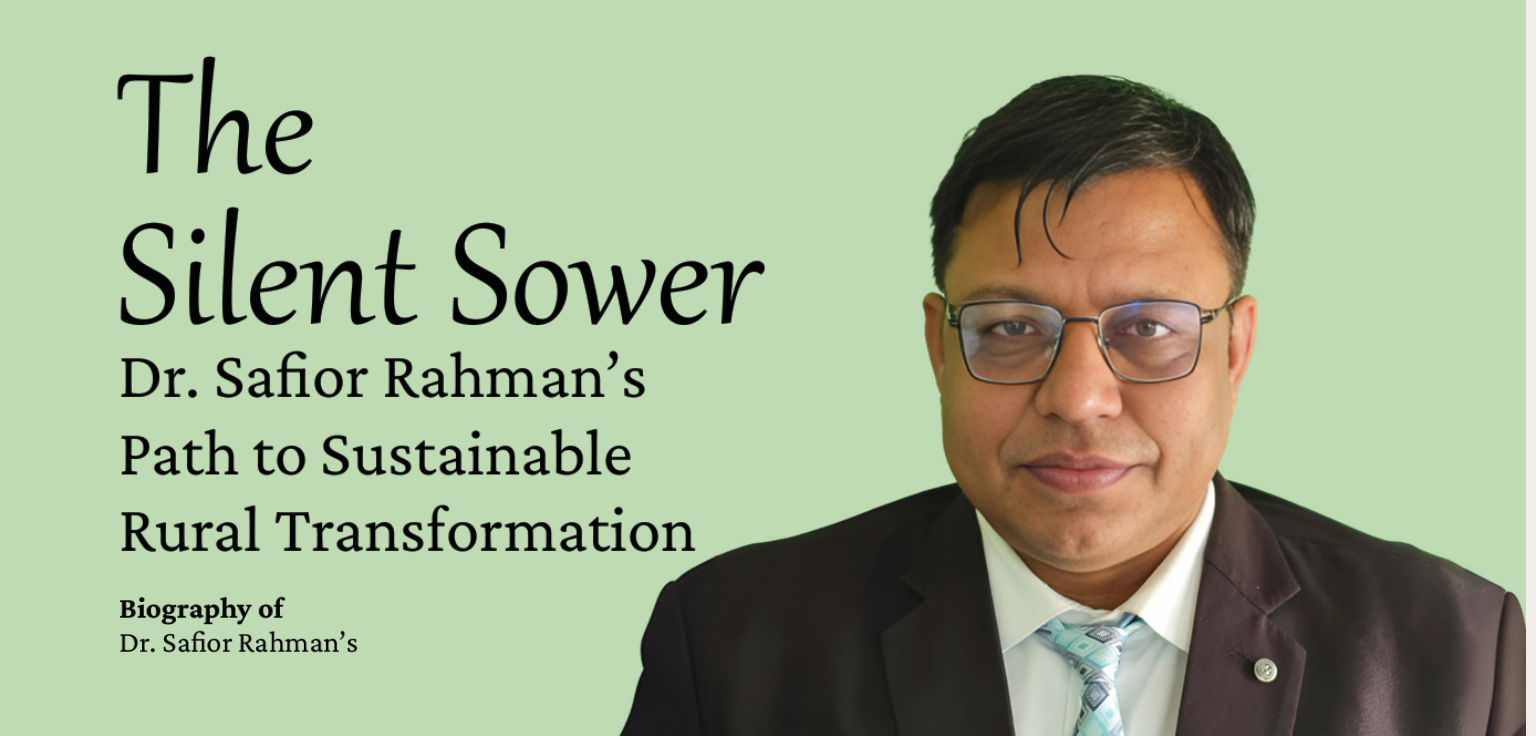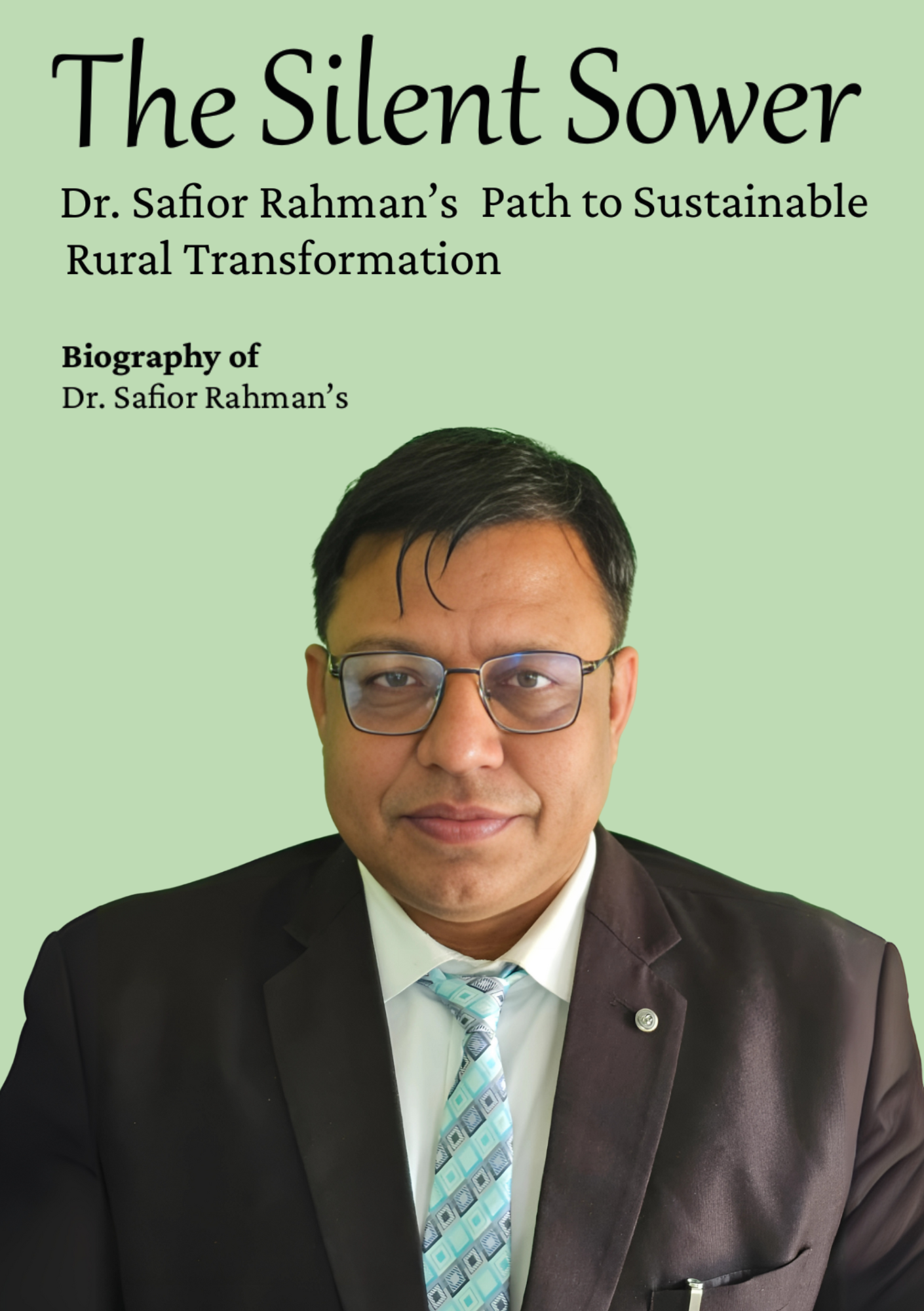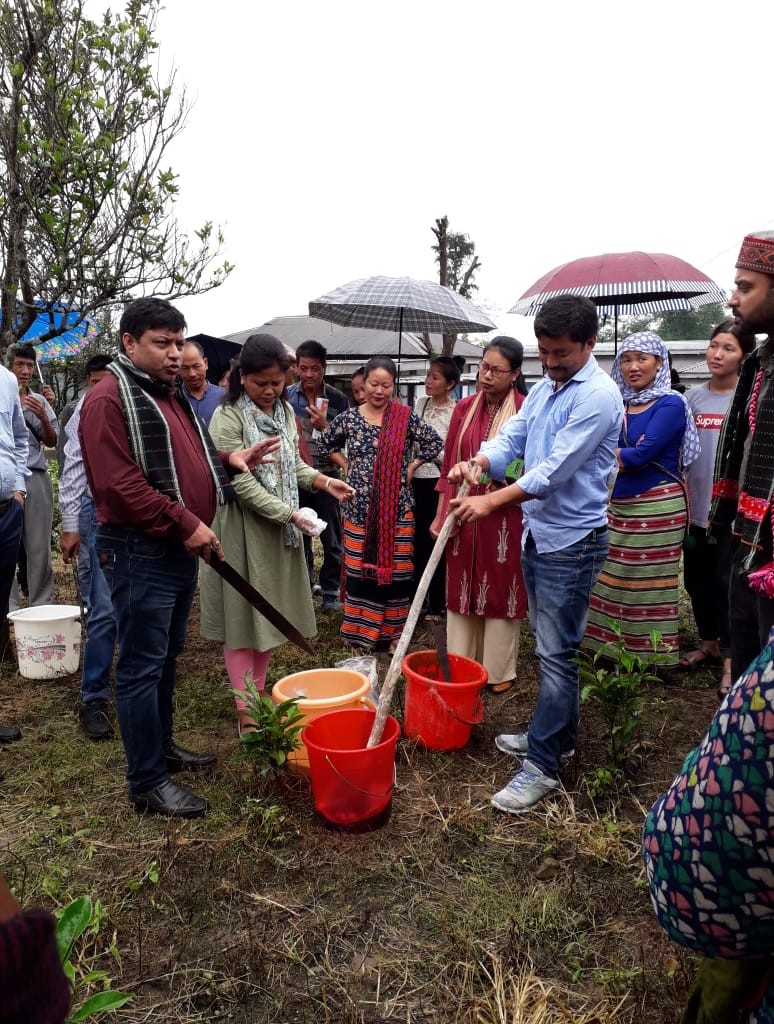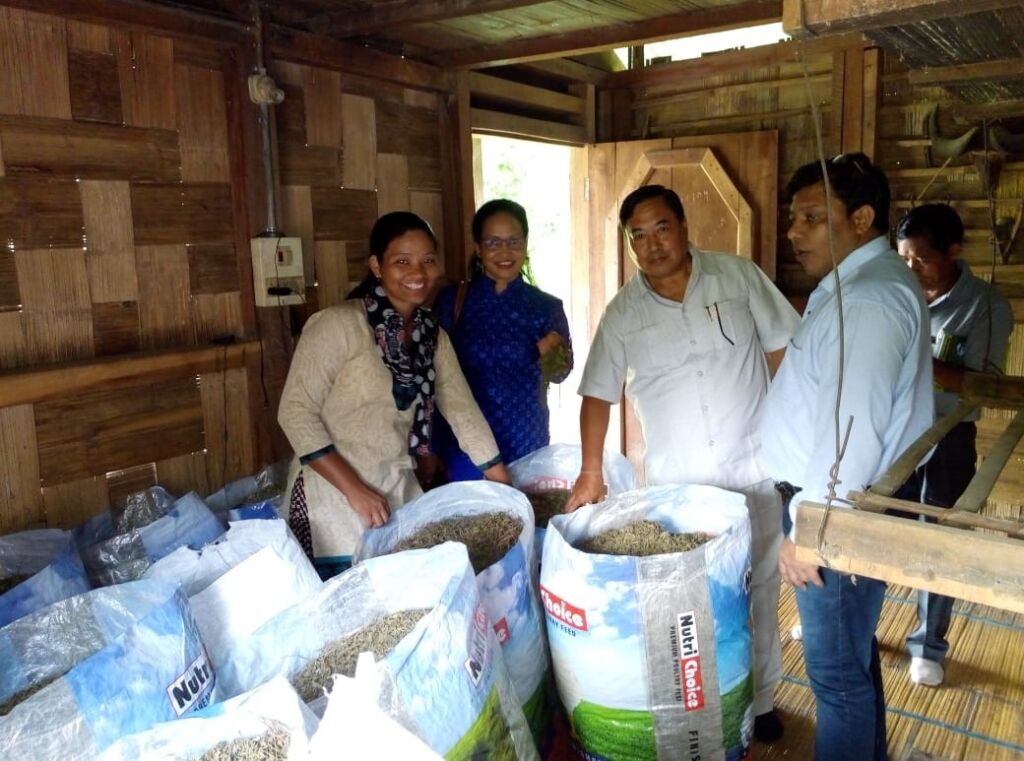

“True leadership in rural transformation means empowering
communities to shape their own future—where innovation blends
with tradition, and every smallholder, especially women, becomes a
driver of sustainable growth. My vision is a rural India that thrives
on self-reliance, inclusiveness, and ecological responsibility. I hope
my legacy will be remembered as one rooted in service, innovation,
and the empowerment of rural communities. My journey was never
about personal achievement, but about becoming a catalyst for
change—transforming the horticulture sector in places like Tawang
into engines of sustainable development. I envision a future where
farmers are not merely beneficiaries, but leaders—proud of their
culture, deeply connected to their land, and confident in their
ability to thrive. If my work has inspired even a few to believe in this
vision and carry it forward, I will consider it a legacy fulfilled.”
— Dr. Safior Rahman
Dedication
This biography is lovingly and reverently dedicated to the pillars of my life—those whose love, guidance, and quiet strength have shaped every part of who I am today.
To my late grandfather, Late Mr. Rai Bahadur Gupta, whose wisdom, dignity, and values continue to echo through the generations. Though I did not have the privilege of walking many steps beside you, your legacy lives on in the choices I make and the life I strive to build. Your name remains a symbol of integrity and honor, and I carry it forward with pride and humility.
To my parents, Mr. Dharam Dev Gupta and Mrs. Vijaya Gupta, the true architects of my journey. Papa, your hard work, courage, and sacrifices laid the foundation of everything I stand upon today. Even when life tested you with unimaginable challenges, you stood tall so that I could dream without limits. Mummy, your unconditional love, your prayers, and your endless support have been my comfort in storms and my joy in triumphs. You both are the reason my heart remains rooted in gratitude, no matter how far I go.
To my sister, Shalini Agarwal, who has been my lifelong friend, protector, and cheerleader. Shalu Didi, your quiet wisdom, your strength in adversity, and your loving heart have always reminded me that family is life’s greatest blessing. And to my brother-in-law, Rahul Agarwal, thank you for being a steady and positive force in our family. Your kindness and support have enriched our lives and brought us closer as a family.
To my beloved wife, Dr. Arushi, my companion in every joy and sorrow, the heartbeat of my life’s journey. Arushi, your unwavering belief in me, your calm wisdom in difficult times, and your boundless love have been my refuge and my strength. You walked beside me through life’s sharpest turns and most uncertain roads without ever letting go of my hand. This journey has been ours, and I would not have wanted to walk it with anyone else but you.
This story is also for those who feel burdened by responsibilities too big for their shoulders, and for anyone who has faced life’s storms and still dared to dream. Let it remind you that every trial contains a lesson, and every fall is a chance to rise stronger.
To all of you, my family—your sacrifices and your love are the invisible threads that weave through every chapter of my life. You are my foundation, my strength, and my purpose. Every step I take forward is in honor of what you have built behind me.
– Dr. Honey Gupta
PHASE 1 Rooted in Simplicity, Rising in Resolve
“See, the greatest stories often begin not with riches, but with simplicity and resilience.” — Anonymous
Dr. Safior Rahman was born on 1st February, 1972, into a humble family in Dafarpur, nestled in the Dhubri district of Assam. His father, an earnest man, was a high school teacher in the Department of English in Paglahat High School. At that time, the school where he was posted was a “Venture” School in the remote region of Assam. The school was neither provincialized nor recognized by the government, which meant it operated without the support or benefits of a formal educational institution.
His mother, a full-time homemaker, managed the household with great skill and care, balancing the needs of a growing family on an extremely tight budget. Their life was marked by modesty, simplicity, and the dignity that comes from living within one’s means. There were no luxuries, no excesses, and often not even sufficiency—but there was never a shortage of love, compassion, or support.
His father, despite earning a meager and irregular income, prioritized the education of his children above all. He taught them to work hard, live humbly, and never give up. Education, he firmly believed, was the only ladder that could lift them out of poverty and lead them towards a brighter and more secure future.
The hardships of those early years left an indelible mark on Dr. Safior Rahman’s character. Life was not merely frugal; it was often harsh. His father’s school being unrecognized meant there was no job security and the salary was as inconsistent as the seasons. Yet, his father’s spirit never wavered. Regardless of the weather, he walked miles to school, determined to teach with passion and integrity. It was through his father’s unwavering dedication that young Safior learned the meaning of true resilience.
As a young boy, he could not fully comprehend the gravity of his parents’ struggles, but he could feel the tension in the household when bills went unpaid or meals had to be rationed. His mother carried the weight of these struggles with silent grace. She created a loving and warm home despite the scarcity, showing her children that strength could be soft, and dignity could exist even in deprivation.
Those years taught him lessons that no textbook could—lessons about perseverance, gratitude, and the power of strength.
A major turning point came when little Safior reached Class 9. It was during this time that his father’s school was finally provincialized—a transformation that changed everything. With this shift came a regular salary, stability, and a small but powerful sense of security. The family, for the first time, experienced what it felt like to plan for the future rather than merely survive the present.
They could now afford schoolbooks, proper uniforms, and nutritious meals that had previously been luxuries. That provincialization of the school was not just a financial upliftment, but an emotional milestone. It was as though years of silent sacrifices were finally being recognized.
For young Safior, it meant being able to focus on his education without the gnawing anxiety of family hardship constantly lingering in the background. This newfound stability served as fertile soil for the seeds of ambition to grow. And yet, even as life began to change, he never forgot the journey that led them there. The lessons of humility and hard work remained etched in his heart, reminding him always of the value of every step forward.
Among the many figures who influenced Dr. Safior Rahman’s young mind, one stood out in particular—Mr. Gulok Sharma, the headmaster of Kachakhana High School (junior school). Mr. Sharma was more than an administrator; he was a mentor and a man of integrity who left a lasting impression on all his students.
His famous line, “Winners never quit, and quitters never win,” became a guiding light in times of doubt. He believed in discipline, sincerity, and the untapped potential of every child. Mr. Sharma had a unique ability to make students believe in themselves, no matter their background. He treated each one with fairness and encouraged them to strive for excellence, not for recognition, but for self-respect.
His belief in the transformative power of education matched that of Dr. Safior’s father, reinforcing the ideals he was raised with. In moments when discouragement threatened to derail his motivation, Mr. Sharma’s words echoed in his mind, rekindling his determination to keep pushing forward. He became not just a teacher in Dr. Safior’s life, but a torchbearer of dreams.
PHASE 2 Turning the Page: From a Village Boy to an Achiever
“Education is not the filling of a pail, but the lighting of a fire.”– William Butler Yeats

He passed the Higher Secondary Science (H.S.Sc.) examination in 1990 with First Division. The same year, he joined the prestigious College of Agriculture under Assam Agricultural University (AAU), Jorhat, to pursue a B.Sc. in Agriculture. With strong academic commitment, he completed his degree in 1995. Dr. Safior’s passion for learning continued as he chose to specialize further, completing his M.Sc. in Agricultural Statistics from the same university in 1997, equipping himself with both theoretical and analytical expertise in the field.
Throughout his academic journey, Dr. Safior Rahman demonstrated exceptional qualities—he was sincere, punctual, and hardworking, winning admiration from peers and professors alike. His academic excellence earned him multiple accolades, including a National Scholarship and a Scholarship Loan from the Islamic Development Bank (IDB), Saudi Arabia. He was also awarded the Indian Council of Agricultural Research (ICAR) Junior Fellowship during his post-graduate studies, reflecting the national recognition of his potential. However, young Safior’s talents were not limited to academics. He actively participated in extracurricular activities and distinguished himself in various athletic disciplines. His achievements in athletics, bodybuilding, powerlifting, weightlifting, and arm wrestling brought him numerous gold, silver, and bronze medals at both college and inter-college levels. These accomplishments revealed a personality driven by discipline, resilience, and a strong sense of purpose.
The Influence of Dr. M. M. Kalita
During his student life, Dr. Rahman also had the opportunity to engage with numerous inspiring individuals—scientists, professors, public leaders, and administrators—whose guidance deeply shaped his values and aspirations. Among the most influential was Dr. Manjura Mohan Kalita, the Chief Warden cum-Associate Director of Student’s Welfare (ADSW), who left a lasting impression on him. This individual’s emphasis on compassion, integrity, and service in agricultural sciences deeply resonated with young Safior and helped him understand the true purpose of agricultural service—to uplift rural lives with dedication and humility.
With calm wisdom and unfailing support, Dr. Kalita offered him something no textbook could—belief. His mentorship transcended the boundaries of the classroom and touched every facet of Dr. Safior’s development. He introduced him to the idea of leadership not as power, but as purpose. Their conversations, often held under trees or in quiet corridors, planted the seeds of confidence and clarity. He nurtured the notion that education should empower one to serve, to uplift, and to imagine boldly. Under his guidance, Dr. Safior began engaging actively in university life—taking part in debates, organizing student programs, and discovering the power of voice and initiative.
Dr. Kalita often reminded his students that success was not born of comfort but carved from challenge. Through his example, Dr. Rahman learned that academic brilliance must walk hand-in-hand with moral integrity. Slowly but surely, the hesitant boy evolved into a poised young man with vision. He began to see his life not as a series of burdens, but as a platform for change. This period, under Dr. Kalita’s wing, was the crucible that forged his character. To this day, the gratitude Dr. Rahman holds for him is deep, unwavering, and sacred—a chapter etched in reverence in the story of his becoming.
Thus, the path from a financially constrained childhood in a remote corner of Assam to becoming a determined, confident scholar was far from smooth—but it was undeniably meaningful. It was a journey built on small sacrifices, late-night studies, moments of fear, unexpected encouragement, and deep resilience. Dr. Safior Rahman’s story is one of unwavering commitment—of showing up every single day, guided by a vision far greater than personal success. Each obstacle became a catalyst for growth, and every failure was transformed into fuel for progress. From walking miles to school with borrowed books to cracking competitive examinations through sheer willpower, his life reflects the quiet courage of someone who refused to be defined by his circumstances. Rather than surrender to limitations, he forged his own path with tenacity and humility. Today, his achievements are not only milestones of individual excellence but also enduring symbols of what can be accomplished through hard work, integrity, and a deeply rooted desire to uplift others.
PHASE 3 A Profession of Agricultural Innovation and Welfare
“True development is not when we build systems, but when people rise with them.” — Albert Einstein

After successfully completing his M.Sc. (Agri) in Agricultural Statistics in 1997 from Assam Agricultural University, Dr. Rahman set his sights on public service. That same year, he appeared for the Combined Competitive Examination conducted by the Arunachal Pradesh Public Service Commission. His hard work and academic excellence paid off when he qualified for the post of Extension Officer (Horticulture). His first posting was at Nyapin, a remote but scenic region in the then Lower Subansiri district of Arunachal Pradesh. This role marked the beginning of his professional journey in the field of horticultural development and on May 13, 1997, when he assumed the role of Horticulture Development Officer under the Government of Arunachal Pradesh. Life in Nyapin was challenging for both administrators and the tribal farming communities. But rather than be deterred, Dr. Rahman saw opportunity. He engaged directly with farmers, patiently winning their trust and educating them on the prospects of horticulture. His earliest interventions included the introduction of crops like pear, orange, and large cardamom.
What seemed novel to the farmers soon proved to be transformative. Through meticulous groundwork, field demonstrations, and constant motivation, he established fruit gardens in farmers’ fields. These interventions not only increased the income of tribal families but also laid the foundation of a horticultural ecosystem in a region previously known only for subsistence farming. In July 2000, Dr. Rahman was transferred briefly to Aalo, where he served for two months, maintaining the same enthusiasm and hands-on approach.
Kiwi Dreams: Transforming the Landscape of Tawang
Dr. Rahman’s subsequent posting to Tawang became one of the most defining chapters of his career. Tawang, located in a temperate climatic zone and known for its cultural heritage and strategic significance, was relatively untapped in terms of horticultural potential. Dr. Rahman recognized this gap and envisioned something revolutionary—kiwi cultivation. Prior to his intervention, kiwi was virtually unknown in the district. He initiated the establishment of six acres of kiwi plantations in six different villages. The varieties introduced—Hayward female and Tomuri male, as well as Allison, Bruno, and Monty female with Allison male—were carefully selected for the region’s altitude and climate. This pioneering step did not just offer a new, high-value crop to local farmers; it introduced the region to horticulture-based tourism, as the green canopy of kiwi vines added to the visual charm of Tawang. His work inspired local communities and was soon emulated by others.
Rupa’s Tomato Revolution: A Model for Off-Season Farming
Dr. Rahman’s next posting took him to Rupa in West Kameng district, where he led an initiative that changed the seasonal dynamics of farming—off-season tomato cultivation. Recognizing the demand-supply mismatch and the potential profitability of off-season vegetables, he introduced and promoted techniques to grow tomatoes during non-traditional periods. Under the Mission for Integrated Development of Horticulture (MIDH), he offered both technical guidance and financial aid. The initiative was met with enthusiasm, and within a short span, Rupa saw a substantial rise in farmers’ incomes. His success in Rupa set a precedent for other regions, transforming Rupa into a model sub-division for off-season vegetable cultivation. Farmers who once migrated for labor opportunities were now earning sustainably from their land. The transformation wasn’t just agricultural—it was social.